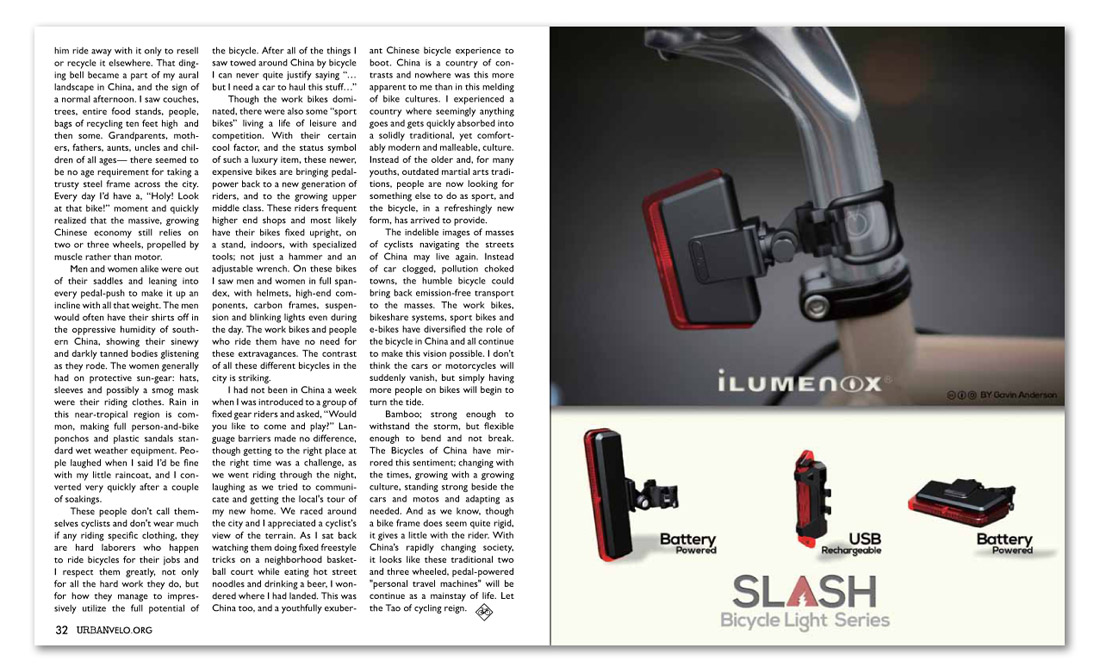


him ride away with it only to resell or recycle it elsewhere. That dinging bell became a part of my aural landscape in China, and the sign of a normal afternoon. I saw couches, trees, entire food stands, people, bags of recycling ten feet high and then some. Grandparents, mothers, fathers, aunts, uncles and children of all ages— there seemed to be no age requirement for taking a trusty steel frame across the city. Every day I’d have a, “Holy! Look at that bike!” moment and quickly realized that the massive, growing Chinese economy still relies on two or three wheels, propelled by muscle rather than motor.
Men and women alike were out of their saddles and leaning into every pedal-push to make it up an incline with all that weight. The men would often have their shirts off in the oppressive humidity of southern China, showing their sinewy and darkly tanned bodies glistening as they rode. The women generally had on protective sun-gear: hats, sleeves and possibly a smog mask were their riding clothes. Rain in this near-tropical region is common, making full person-and-bike ponchos and plastic sandals standard wet weather equipment. People laughed when I said I’d be fine with my little raincoat, and I converted very quickly after a couple of soakings.
These people don’t call themselves cyclists and don't wear much if any riding specific clothing, they are hard laborers who happen to ride bicycles for their jobs and I respect them greatly, not only for all the hard work they do, but for how they manage to impressively utilize the full potential of the bicycle. After all of the things I saw towed around China by bicycle I can never quite justify saying “…but I need a car to haul this stuff…”
Though the work bikes dominated, there were also some “sport bikes” living a life of leisure and competition. With their certain cool factor, and the status symbol of such a luxury item, these newer, expensive bikes are bringing pedal-power back to a new generation of riders, and to the growing upper middle class. These riders frequent higher end shops and most likely have their bikes fixed upright, on a stand, indoors, with specialized tools; not just a hammer and an adjustable wrench. On these bikes I saw men and women in full spandex, with helmets, high-end components, carbon frames, suspension and blinking lights even during the day. The work bikes and people who ride them have no need for these extravagances. The contrast of all these different bicycles in the city is striking.
I had not been in China a week when I was introduced to a group of fixed gear riders and asked, “Would you like to come and play?” Language barriers made no difference, though getting to the right place at the right time was a challenge, as we went riding through the night, laughing as we tried to communicate and getting the local's tour of my new home. We raced around the city and I appreciated a cyclist’s view of the terrain. As I sat back watching them doing fixed freestyle tricks on a neighborhood basketball court while eating hot street noodles and drinking a beer, I wondered where I had landed. This was China too, and a youthfully exuberant Chinese bicycle experience to boot. China is a country of contrasts and nowhere was this more apparent to me than in this melding of bike cultures. I experienced a country where seemingly anything goes and gets quickly absorbed into a solidly traditional, yet comfortably modern and malleable, culture. Instead of the older and, for many youths, outdated martial arts traditions, people are now looking for something else to do as sport, and the bicycle, in a refreshingly new form, has arrived to provide.
The indelible images of masses of cyclists navigating the streets of China may live again. Instead of car clogged, pollution choked towns, the humble bicycle could bring back emission-free transport to the masses. The work bikes, bikeshare systems, sport bikes and e-bikes have diversified the role of the bicycle in China and all continue to make this vision possible. I don’t think the cars or motorcycles will suddenly vanish, but simply having more people on bikes will begin to turn the tide.
Bamboo; strong enough to withstand the storm, but flexible enough to bend and not break. The Bicycles of China have mirrored this sentiment; changing with the times, growing with a growing culture, standing strong beside the cars and motos and adapting as needed. And as we know, though a bike frame does seem quite rigid, it gives a little with the rider. With China’s rapidly changing society, it looks like these traditional two and three wheeled, pedal-powered "personal travel machines" will be continue as a mainstay of life. Let the Tao of cycling reign.